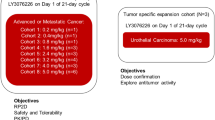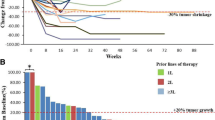Abstract
Purpose
To investigate the pharmacological properties of the CR011-vcMMAE fully human antibody–drug conjugate (ADC), such as dose titrations, quantitation of the time (days) to complete regression, pharmacokinetics, and schedule dependency. Our prior study characterized a fully human antibody to GPNMB covalently linked to monomethylauristatin E, CR011-vcMMAE, and further demonstrated cell surface staining of melanoma lines susceptible to the immunoconjugate’s cytotoxicity (Clin Cancer Res 2005; 12(4): 1373–1382).
Methods
The human SK-MEL-2 and SK-MEL-5 melanoma xenografts were used in athymic mice to assess anti-tumor efficacy. After s.c. implantation, tumors became established (60–100 mg), and treatment commenced by i.v. injection of the immunoconjugate or vinblastine or paclitaxel. Short-term anti-tumor effects (inhibition of tumor growth) and long-term effects (complete regression) were observed.
Results
CR011-vcMMAE induced regression of established human SK-MEL-2 and SK-MEL-5 xenografts at doses from 1.25 to 80 mg/kg treatment when administered intravenously every 4 days (4 treatments); strikingly, regressions were not associated with re-growth during the observation period (200 days). The disappearance rate of implants was dose dependent (minimum time, 18.5 days). Detectable serum CR011-vcMMAE ≥1 μg/mL (∼0.01 μM) was observed for >30 days post-dose; CR011-vcMMAE showed an elimination half-life of 10.3 days. A low volume of distribution suggested that CR011-vcMMAE was confined to blood and interstitial fluid. CR011-vcMMAE could be delivered by either a single bolus dose or by intermittent dosing (i.e., every 1, 2, 4, 8, or 16 days) with no discernible differences in the proportion of tumor-free survivors, indicating a lack of schedule dependency. The antibody–drug conjugate produced complete regressions, but the equivalent doses of free monomethylauristatin E or unconjugated antibody did not show anti-tumor effects. In addition, decreases in plasma tumor-derived human interleukin-8 coincided with tumor nodule disappearance.
Conclusions
Short-term anti-tumor effects and long-term effects (complete regression) were observed with CR011-vcMMAE, but not with the reference agents. These results suggest that CR011-vcMMAE may provide therapeutic benefit in malignant melanoma.






Similar content being viewed by others
Notes
US National Institutes of Health, Physicians Data Query, PDQ http://www.cancer.gov
Abbreviations
- CR:
-
Complete regression
- C.V.:
-
Coefficient of variation
- GPNMB:
-
Glycoprotein NMB
- MMAE:
-
Monomethylauristatin E
- MTD:
-
Maximum tolerated dose
- ROA:
-
Route of administration
References
Afar DE, Bhaskar V, Ibsen E, et al (2004) Preclinical validation of anti-TMEFF2-auristatin E-conjugated antibodies in the treatment of prostate cancer. Mol Cancer Ther 3:921–932
Aldrich TL, Viaje A, Morris AE (2003) EASE vectors for rapid stable expression of recombinant antibodies. Biotechnol Prog 19:1433–1438
Atkins MB, Elder DE, Essner R, et al (2006) Innovations and challenges in melanoma: summary statement from the first Cambridge conference. Clin Cancer Res 12:2291s–2296s
Bar-Eli M (1999) Role of interleukin-8 in tumor growth and metastasis of human melanoma. Pathobiology 67:12–18
Bennicelli JL, Guerry Dt (1993) Production of multiple cytokines by cultured human melanomas. Exp Dermatol 2:186–190
Bhaskar V, Law DA, Ibsen E, et al (2003) E-selectin up-regulation allows for targeted drug delivery in prostate cancer. Cancer Res 63:6387–6394
Brennecke S, Deichmann M, Naeher H, Kurzen H (2005) Decline in angiogenic factors, such as interleukin-8, indicates response to chemotherapy of metastatic melanoma. Melanoma Res 15:515–522
Cruz-Monserrate Z, Mullaney JT, Harran PG, Pettit GR, Hamel E (2003) Dolastatin 15 binds in the vinca domain of tubulin as demonstrated by Hummel–Dreyer chromatography. Eur J Biochem 270:3822–3828
Doronina SO, Mendelsohn BA, Bovee TD, Cerveny CG, Alley SC, Meyer DL, Oflazoglu E, Toki BE, Sanderson RJ, Zabinski RF, Wahl AF, Senter PD (2006) Enhanced activity of monomethylauristatin F through monoclonal antibody delivery: effects of linker technology on efficacy and toxicity. Bioconjug Chem 17:114–124
Doronina SO, Toki BE, Torgov MY, et al (2003) Development of potent monoclonal antibody auristatin conjugates for cancer therapy. Nat Biotechnol 21:778–784
Dykes DJ, Abbott BJ, Mayo JG, et al (1992) Development of human tumor xenograft models for in vivo evaluation of new antitumor drugs. In: Fiebig HH, Berger DP (eds) Immunodeficient mice in oncology. Contrib Oncol, vol 42. Karger, Basel, pp 1–22
Fogh J, Fogh JM, Orfeo T (1977) One hundred and twenty-seven cultured human tumor cell lines producing tumors in nude mice. J Natl Cancer Inst 59:221–226
Francisco JA, Cerveny CG, Meyer DL, et al (2003) cAC10-vcMMAE, an anti-CD30-monomethyl auristatin E conjugate with potent and selective antitumor activity. Blood 102:1458–1465
Geran RI, Greenberg NH, Macdonald MM, Schumacher AM, Abbott BJ (1972) Protocols for screening chemical agents and natural products against animal tumors and other biological systems. Cancer Chemother Rep 3:1–104
Gitler MS, Sausville EA, Hollingshead M, Shoemaker R (2004) In vivo models for experimental therapeutics relevant to human cancer. Cancer Res 64:8478–8480
Hamblett KJ, Senter PD, Chace DF, et al (2004) Effects of drug loading on the antitumor activity of a monoclonal antibody drug conjugate. Clin Cancer Res 10:7063–7070
Huang S, DeGuzman A, Bucana CD, Fidler IJ (2000) Nuclear factor-kappaB activity correlates with growth, angiogenesis, and metastasis of human melanoma cells in nude mice. Clin Cancer Res 6:2573–2581
Jeffrey SC, Andreyka JB, Bernhardt SX, Kissler KM, Kline T, Lenox JS, Moser RF, Nguyen MT, Okeley NM, Stone IJ, Zhang X, Senter PD (2006) Development and properties of beta-glucuronide linkers for monoclonal antibody–drug conjugates. Bioconjug Chem 17:831–840
Johnson JI, Decker S, Zaharevitz D, et al (2001) Relationships between drug activity in NCI preclinical in vitro and in vivo models and early clinical trials. Br J Cancer 84:1424–1431
Jordan MA, Wilson L (2004) Microtubules as a target for anticancer drugs. Nat Rev Cancer 4:253–265
Kaplan EL, Meier P (1958) Nonparametric estimation from incomplete observations. J Am Statistical Assoc 53:457–481
Kobayashi M, Natsume T, Tamaoki S, Watanabe J, Asano H, Mikami T, Miyasaka K, Miyazaki K, Gondo M, Sakakibara K, Tsukagoshi S (1997) Antitumor activity of TZT-1027, a novel dolastatin 10 derivative. Jpn J Cancer Res 88:316–327
Koch AE, Polverini PJ, Kunkel SL, et al (1992) Interleukin-8 as a macrophage-derived mediator of angiogenesis. Science 258:1798–1801
Lazar-Molnar E, Hegyesi H, Toth S, Falus A (2000) Autocrine and paracrine regulation by cytokines and growth factors in melanoma. Cytokine 12:547–554
Le Borgne R, Planque N, Martin P, Dewitte F, Saule S, Hoflack B (2001) The AP-3-dependent targeting of the melanosomal glycoprotein QNR-71 requires a di-leucine-based sorting signal. J Cell Sci 114:2831–2841
Lobo ED, Hansen RJ, Balthasar JP (2004) Antibody pharmacokinetics and pharmacodynamics. J Pharm Sci 93:2645–2668
Lu C, Kerbel RS (1994) Cytokines, growth factors and the loss of negative growth controls in the progression of human cutaneous malignant melanoma. Curr Opin Oncol 6:212–220
Mahmood I, Green MD (2005) Pharmacokinetic and pharmacodynamic considerations in the development of therapeutic proteins. Clin Pharmacokinet 44:331–347
Mao W, Luis E, Ross S, et al (2004) EphB2 as a therapeutic antibody drug target for the treatment of colorectal cancer. Cancer Res 64:781–788
Mattei S, Colombo MP, Melani C, Silvani A, Parmiani G, Herlyn M (1994) Expression of cytokine/growth factors and their receptors in human melanoma and melanocytes. Int J Cancer 56:853–857
McDonagh CF, Turcott E, Westendorf L, et al (2006) Engineered antibody–drug conjugates with defined sites and stoichiometries of drug attachment. Protein Eng Des Sel 19(7):299–307
Miyazaki K, Kobayashi M, Natsume T, Gondo M, Mikami T, Sakakibara K, Tsukagoshi S (1995) Synthesis and antitumor activity of novel dolastatin 10 analogs. Chem Pharm Bull (Tokyo) 43:1706–1718
Mohammad RM, Varterasian ML, Almatchy VP, Hannoudi GN, Pettit GR, Al-Katib A (1998) Successful treatment of human chronic lymphocytic leukemia xenografts with combination biological agents auristatin PE and bryostatin 1. Clin Cancer Res 4:1337–1343
Natsume T, Watanabe J, Tamaoki S, Fujio N, Miyasaka K, Kobayashi M (2000) Characterization of the interaction of TZT-1027, a potent antitumor agent, with tubulin. Jpn J Cancer Res 91:737–747
Owen TA, Smock SL, Prakash S, et al (2003) Identification and characterization of the genes encoding human and mouse osteoactivin. Crit Rev Eukaryot Gene Expr 13:205–220
Pettit GR, Srirangam JK, Barkoczy J, et al (1995) Antineoplastic agents 337. Synthesis of dolastatin 10 structural modifications. Anticancer Drug Des 10:529–544
Plowman J, Dykes DJ, Hollingshead M, Simpson-Herren L, Alley MC (1997) Human tumor xenograft models in NCI drug development Anticancer drug development guide: preclinical screening, clinical trials, and approval. In: Teicher B (ed) Humana Press, Totowa, pp 102–125
Pollack VA, Savage DM, Baker DA, et al (1999) Inhibition of epidermal growth factor receptor-associated tyrosine phosphorylation in human carcinomas with CP-358,774: dynamics of receptor inhibition in situ and antitumor effects in athymic mice. J Pharmacol Exp Ther 291:739–748
Rodeck U (1993) Growth factor independence and growth regulatory pathways in human melanoma development. Cancer Metastasis Rev 12:219–226
Schadendorf D, Moller A, Algermissen B, Worm M, Sticherling M, Czarnetzki BM (1993) IL-8 produced by human malignant melanoma cells in vitro is an essential autocrine growth factor. J Immunol 151:2667–2675
Shikano S, Bonkobara M, Zukas PK, Ariizumi K (2001) Molecular cloning of a dendritic cell-associated transmembrane protein, DC-HIL, that promotes RGD-dependent adhesion of endothelial cells through recognition of heparan sulfate proteoglycans. J Biol Chem 276:8125–8134
Shimkets RA, Lowe DG, Tai JT, et al (1999) Gene expression analysis by transcript profiling coupled to a gene database query. Nat Biotechnol 17:798–803
Strieter RM, Kunkel SL, Elner VM, et al (1992) Interleukin-8. A corneal factor that induces neovascularization. Am J Pathol 141:1279–1284
Sun MM, Beam KS, Cerveny CG, Hamblett KJ, Blackmore RS, Torgov MY, Handley FG, Ihle NC, Senter PD, Alley SC (2005) Reduction–alkylation strategies for the modification of specific monoclonal antibody disulfides. Bioconjug Chem 16:1282–1290
Tse KF, Jeffers M, Pollack VA, et al (2006) CR011, a fully human monoclonal antibody-auristatin E conjugate, for the treatment of melanoma. Clin Cancer Res 12:1373–1382
Weterman MA, Ajubi N, van Dinter IM, et al (1995) nmb, a novel gene, is expressed in low-metastatic human melanoma cell lines and xenografts. Int J Cancer 60:73–81
Wu AM, Senter PD (2005) Arming antibodies: prospects and challenges for immunoconjugates. Nat Biotechnol 23:1137–1146
Acknowledgments
We wish to thank Michael Gallo and Gadi Gazit-Bornstein (Abgenix Biopharma, Fremont, CA), and Damon Meyer (Seattle Genetics, Inc., Bothell, WA) who contributed significantly to design of the ADC. For expertise in animal experimentation, we are grateful to Donald Dykes and Murray Stackhouse of Southern Research Institute (Birmingham, AL), as well as Michael Wick, Jennifer Marty and Marla Lear of the Institute for Drug Development (San Antonio, TX). We are also indebted to Bruce Mico for pharmacokinetic analysis, Steven Henck for helpful discussions and to Traci Mansfield for program management.
Author information
Authors and Affiliations
Corresponding author
Rights and permissions
About this article
Cite this article
Pollack, V.A., Alvarez, E., Tse, K.F. et al. Treatment parameters modulating regression of human melanoma xenografts by an antibody–drug conjugate (CR011-vcMMAE) targeting GPNMB. Cancer Chemother Pharmacol 60, 423–435 (2007). https://doi.org/10.1007/s00280-007-0490-z
Received:
Accepted:
Published:
Issue Date:
DOI: https://doi.org/10.1007/s00280-007-0490-z




